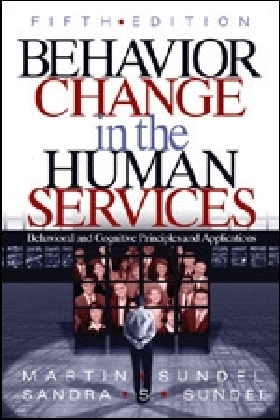
Behavior Change in the Human Services
SAGE Publications Inc (Verlag)
978-0-7619-8870-0 (ISBN)
- Titel erscheint in neuer Auflage
- Artikel merken
Behavior Change in the Human Services, Fifth Edition features a detailed and sequential organization that encourages readers to move progressively through material of increasing complexity and to conduct self-assessments of their knowledge. The Fifth Edition includes eight clinical case studies and many new and engaging examples that address issues such as substance abuse, child behavior problems, assertiveness, marital discord, and developing appropriate social behaviors. The expanded chapter on intervention techniques incorporates empirically tested behavioral and cognitive strategies for addressing clinical problems such as phobias, anxiety disorders, depression, and other behavioral disorders. Current developments and trends in the field are discussed, including the movement toward evidence-based practice.
This comprehensive yet accessible text also features figures, charts, and forms to demonstrate data collection and analysis. Any student pursuing a career in the helping professions, including social work, psychology, counseling, special education, nursing, and psychiatry, will find this book valuable.
Martin Sundel is the director of Clinical Services for Sun Family Care, a company that provides care management and counseling to older adults. He was the Dulak Professor of Social Work at the University of Texas at Arlington and also served on the faculties of the University of Michigan, the University of Louisville, and Florida International University. He holds a PhD in social work and psychology from the University of Michigan and was a postdoctoral fellow at the Laboratory of Community Psychiatry at Harvard Medical School. He is a Charter Clinical Fellow of the Behavior Therapy and Research Society and has been recognized as a pioneer in introducing behavior therapy in Latin America. He has published extensively on the application of behavioral science knowledge to the helping professions. An avid table tennis player, he has won three national championships and silver and bronze medals in international tournaments. Sandra S. Sundel is the president and CEO of Sun Family Care. She was formerly on the social work faculty at Florida Atlantic University. She was executive director of family service agencies in Florida and Texas, and also served as executive director of group homes for adults with developmental disabilities in Texas. She holds an MSSW from the University of Louisville and a PhD in clinical social work from the University of Texas at Arlington. She has taught courses in social work practice, behavior therapy, interpersonal communication, and group work, and has conducted numerous workshops and seminars. She has consulted with corporations, government agencies, and nonprofit organizations on organizational behavior management and interpersonal communication in the workplace. As mental health consultants to the United Nations High Commissioner for Refugees (UNHCR) in Cyprus, Sandra and Martin designed and implemented a psychosocial rehabilitation project to foster collaborative relationships between Greek and Turkish Cypriots.
PREFACE
TO THE STUDENT: HOW TO USE THIS BOOK
Course Materials
Case Examples
The Chapters
The Course Posttest
Scoring
Recommendations for Instructor Use of This Book
INTRODUCTION
Origins of the Behavioral and Cognitive-Behavioral Approaches
Comparing the Behavioral and Cognitive Approaches
Characteristics of Behavior Change Approaches
Cultural Diversity
Chapter 1. SPECIFYING BEHAVIOR
Objectives
Overt and Covert Behaviors
Clarifying Vague Terms and Fuzzy Language
Target Behavior
Measuring Response Strength
Behavioral Assessment Approach
Summary
Suggested Activities
References and Resources
Chapter 2. POSITIVE REINFORCEMENT
Objectives
Reinforcing Stimuli
Examples of Positive Reinforcement
Reinforcers and Rewards
Factors That Influence Reinforcer Effectiveness
How to Identify Potential Reinforcers
Reinforcer Sampling
How to Evaluate the Effect of a Stimulus as a Positive Reinforcer
Reinforcement of Behavior: Social, Tangible, and Self-Administered
Summary
Suggested Activities
References and Resources
Chapter 3. EXTINCTION
Objectives
Decreasing Response Strength
Single-Subject Evaluation Designs
Applying Extinction to Decrease Undesired Behaviors
Ethical Considerations
Effects of Extinction
Consistency and Control of Reinforcement
Positive Reinforcement of Appropriate Behaviors
Spontaneous Recovery
Summary
Suggested Activities
References and Resources
Chapter 4. POSITIVE REINFORCEMENT CONTINGENCIES
Objectives
Behavioral Contingencies and Positive Reinforcement
Contingency Contracting
Accidental Reinforcement Contingencies
Self-Control Reinforcement Contingencies
The Premack Principle
Continuous and Intermittent Reinforcement
Summary
Suggested Activities
References and Resources
Chaper 5. SHAPING AND RESPONSE DIFFERENTIATION
Objectives
Differential Reinforcement
Response Class
The DRO Procedure
Shaping With Successive Approximations
Summary
Suggested Activities
References and Resources
Chapter 6. STIMULUS CONTROL: DISCRIMINATION AND GENERALIZATION
Objectives
Antecedents
The Discrimination Training Procedure
Stimulus Control
Rule-Governed Behavior
Stimulus Fading
Summary
Suggested Activities
References and Resources
Chapter 7. CONDITIONED REINFORCEMENT AND CHAINING
Objectives
Conditioned Reinforcement
Simple and Generalized Conditioned Reinforcers
Establishing a Conditioned Reinforcer
Reinforcement History
Establishing Relationships With Clients
Fading Out Unconditioned Reinforcers
Token Economy
Stimulus-Response Chains
Response Priming
Backward Chaining
Summary
Suggested Activities
Chapter 8. MODELING AND IMITATION
Objectives
The Role of Imitation in the Acquisition of Behaviors
The Use of Modeling in the Acquisition of New Behaviors
Modeling Versus Shaping
The Modeling Plus Positive Reinforcement Procedure
Application of Modeling in Practice
Assertiveness Training
Summary
Suggested Activities
References and Resources
Chapter 9. PUNISHMENT
Objectives
Punishment Defined
Aversive Stimuli and Punishers
Positive Punishment
Negative Punishment
Extinction and Negative Punishment
Time-Out
Maximizing the Effectiveness of Punishment
Disadvantages of Punishment
Alternatives to Punishment
Overcorrection
Punishment and Self-Control
The Future of Punishment
Summary
Suggested Activities
References and Resources
Chapter 10. NEGATIVE REINFORCEMENT
Objectives
Negative Reinforcers, Punishers, and Aversive Stimuli
Escape Behavior
Escape and Punishment
Avoidance Behavior
Phobias and Negative Reinforcement
Superstitious Behavior and Negative Reinforcement
Negative Reinforcement and Interpersonal Relationships
Summary
Suggested Activities
References and Resources
Chapter 11. RESPONDENT CONDITIONING
Objectives
Respondent Behavior
Respondent Conditioning
Emotional Behavior
Respondent Conditioning of Phobias
Escape, Avoidance, and Respondent Conditioning
Operant and Respondent Control of Behaviors
Summary
Suggested Activities
References and Resources
Chapter 12. GENERALIZATION AND MAINTENANCE OF BEHAVIOR CHANGE
Objectives
Generalization and Maintenance of Behavior Change
Obstacles to Generalization and Maintenance of Behavior Change
Strategies for Promoting Generalization and Maintenance of Behavior Change
Summary
Suggested Activities
References and Resources
Chapter 13. BEHAVIORAL ASSESSMENT
Objectives
Introduction to Behavioral Assessment
Elements of Behavioral Assessment
Sources of Assessment Information
Collecting Assessment Information
Behavioral Assessment and Application of RAC-S
Summary
Suggested Activities
References and Resources
Chapter 14. GOAL SETTING, INTERVENTION PLANNING, AND EVALUATION
Objectives
Formulation Behavior Change Goals
Intervention Planning
Intake, Behavioral Assessment, Goal Setting, Intervention
Treatment Contracts
Classification of Behavior Change Techniques
Ethical Considerations
Developing the Intervention Plan
Implementing the Behavior Change Program for Toothbrushing
Evaluating the Effectiveness of the Behavior Change Program
Behaviorally Oriented Record Keeping
Client Satisfaction
Social Validity
Summary
Suggested Activities
References and Resources
Chapter 15. INTERVENTION TECHNIQUES
Objectives
Exposure Techniques
Cognitive-Behavioral Techniques
Intervention Packages
Evidence-Based Interventions
Practice Guidelines
Conclusion
Summary
Suggested Activities
Appendix 1: Case Examples
Appendix 2: Chapter Pretest Questions
Appendix 3: Chapter Pretest Answers
Appendix 4: Chapter Posttest Questions
Appendix 5: Chapter Posttest Answers
Appendix 6: Course Posttest Questions
Appendix 7: Course Posttest Answers
Appendix 8: Notational Symbols and Diagrams
GLOSSARY
NAME INDEX
SUBJECT INDEX
ABOUT THE AUTHORS
| Erscheint lt. Verlag | 12.10.2004 |
|---|---|
| Verlagsort | Thousand Oaks |
| Sprache | englisch |
| Maße | 177 x 254 mm |
| Gewicht | 680 g |
| Themenwelt | Geisteswissenschaften ► Psychologie ► Allgemeine Psychologie |
| Geisteswissenschaften ► Psychologie ► Verhaltenstherapie | |
| Medizin / Pharmazie ► Medizinische Fachgebiete ► Psychiatrie / Psychotherapie | |
| ISBN-10 | 0-7619-8870-X / 076198870X |
| ISBN-13 | 978-0-7619-8870-0 / 9780761988700 |
| Zustand | Neuware |
| Haben Sie eine Frage zum Produkt? |
aus dem Bereich



